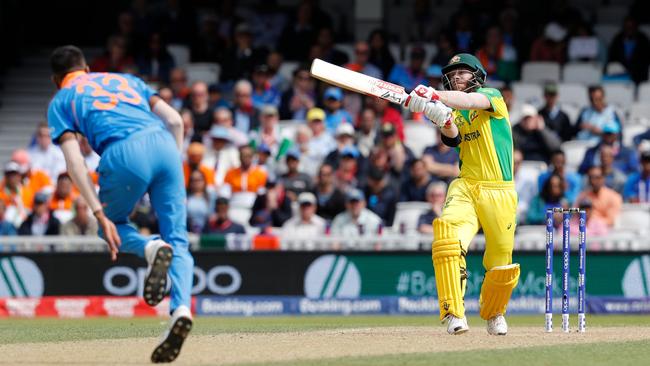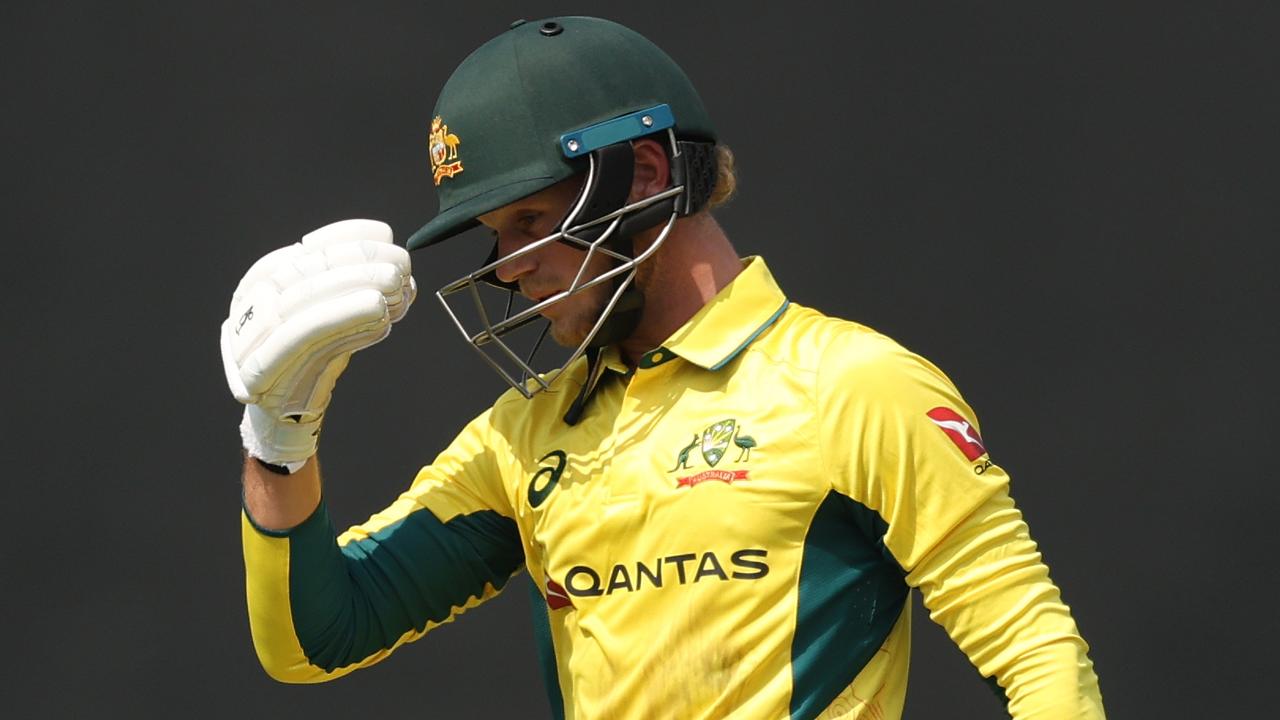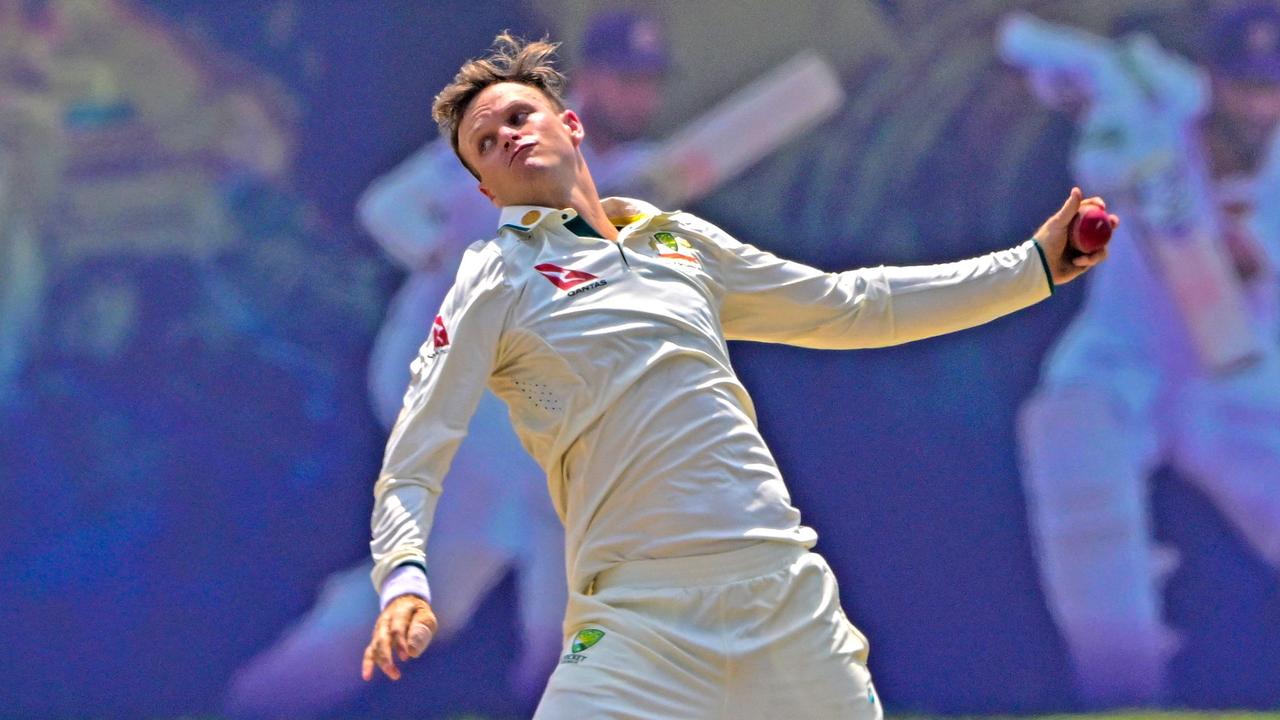Warner plays a slow hand as Aussies struggle to keep pace
Without doubt the strangest of all events at a very strange World Cup is the sight of David Warner batting slow and then slower.

Strange times are upon us. Bails refuse to fall from stumps. Virat Kohli has embraced a Gandhian-like role as protector of the untouchables, friend of outcast Australian cricketers.
England are the most aggressive and feared batsmen in the World Cup. But without doubt the strangest of all events is the sight of David Warner batting slow and then slower.
The phrase “destructive” falls from people’s lips when referring to the hard-hitting left-hander.
It is a perception established by his first T20 innings for Australia and endorsed by occasional withering outbursts.
As a Test cricketer there are few who have ever scored at the same rate as he.
Warner, like Australia, failed to find the traction necessary to chase down India’s 352 in the team’s match at The Oval overnight Sunday. India contained the openers well and forced the error that saw Aaron Finch run out after a careful — too careful — start.
Warner’s half century against Afghanistan in the first match came from 74 balls and was the slowest of his career.
Against India, when haste was needed, it took 77 balls. He didn’t score from 50 of the 84 balls faced on his way to 56, at one stage failing to move off strike for 14 consecutive deliveries.
When he did try to change gears he was caught on the ropes. It’s an odd game, cricket, and was long before fancy Christmas-light bails refused to fall from the top of stumps.
Had the shot come off, Warner would have been away. It didn’t, and Warner finds himself ticking along at 71.8 runs per 100 balls in the tournament, well below his career strike rate of 95.5.
“Davey obviously didn’t have his best day but was able to stick it out for a longer period of time instead of throwing his wicket away early,” Glenn Maxwell said after the match.
“He was able to bat deeper, which is a key thing for us. Unfortunately, the first big risk he took he got out, but another day he hits that for six. It might be the conditions, it might be the ball, not really sure. It seems to be doing a little bit more than what I’ve seen it do over here.”
Credit where it is due. The Indian bowlers and fielders were razor-sharp in defending the side’s total. The opposition noted the Australians were timid and made sure they stayed so.
“We sort of felt like they were a bit hesitant in going for the boundary option, so the communication was very simple: bowl at good lengths but within the stumps and pitch it up, because as a batsman, I know, when you’re not looking for a boundary option, the last ball you want is a length ball on stumps because you have to play a good shot to get a boundary,” Kohli said later.
“I just felt like at that stage they didn’t want to lose wickets was the mentality that we felt, like they wanted to keep it so they could strike big in the end. But I think that was too big a total to play like that initially.”
There is no need to panic. The Australians are finding their feet while India and England have been upright for some time. Warner and company are approaching the mark and there’s every indication they can get there, but the loss to India was an indication of the distance between them and the best sides when things don’t click.
Kohli’s empathy for Steve Smith during the match was the sort of gesture sport craves. As some continue to defend their treatment of Adam Goodes, the display of humanity from someone so historically hostile to Australian cricket was heartwarming and educational.
“I felt bad because if I was in a position where something had happened with me and I had apologised, I accepted it and I came back, and still I would get booed, I wouldn’t like it, either,” Kohli explained.
“So I just felt for him, and I told him, I’m sorry on behalf of the crowd because I’ve seen that happen in a few earlier games as well, and in my opinion that’s not acceptable.”
Kohli understands that to boo somebody constantly is an unnecessary cruelty. It’s not that complicated. Still, the Indian captain is an asset to the game.
One day the penny will drop.
One cannot be so sure about the bails. The blighted light up devices used in this tournament and adapted from the T20 leagues have stayed stubbornly in place when the ball has hit the wicket five times thus far.
Nobody is happy with the situation.
“This is not something which you expect at the international level,” Kohli said. “I think with the technology it’s great. The lights come on and you know it’s very precise when you actually make something happen with the stumps.
“But you literally have to smash the stumps really hard, and I’m saying that as a batsman. If I see something happening like that, I’d be very surprised, also. And these are fast bowlers. These are not your medium-paced bowlers.”
Aaron Finch agrees.
“You’d hate to see something like that happen in a World Cup final or a semi-final or something like that that you’ve done the hard work as a bowler or a fielding side to set a player up or get the mistake and it not be rewarded,” he said.


